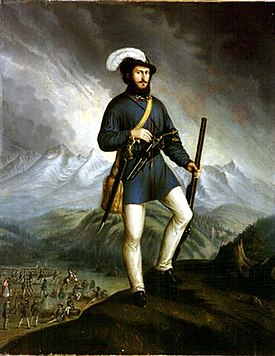Slovak Uprising 1848-1849
| Slovak Uprising of 1848 | |||||||
|---|---|---|---|---|---|---|---|
| Part of the Hungarian Revolution of 1848 | |||||||
 Painting of Capt. Ján Francisci with Slovak volunteers on Miava by Peter Michal Bohúň |
|||||||
|
|||||||
| Belligerents | |||||||
|
|||||||
| Commanders and leaders | |||||||
| Strength | |||||||
| Several thousand volunteers, with Austrian Imperial support | Abt. 80,000 at height | ||||||
| Casualties and losses | |||||||
| Unknown | Unknown | ||||||
The Slovak Uprising (of 1848/49) (Slovak: Slovenské povstanie) or Slovak Volunteer Campaigns (Slovak: Slovenské dobrovoľnícke výpravy) was an uprising of Slovaks against the Hungarian rule in Western parts of Upper Hungary (now Western Slovakia), within the 1848–49 revolutions in the Habsburg Monarchy. It lasted from September 1848 to November 1849.
The year 1848 is well-noted in history as a peaking moment in nationalist sentiment among European nationalities. The Slovak nation, though not fully conscious of ethnicity in 1848, were certainly an important part of the general revolts occurring in the lands of the Habsburg Monarchy. After the revolutionary fervor left Paris in 1848 it traveled to Vienna, where a popular uprising ousted the reactionary government of Prince Klemens von Metternich on 13 March 1848. This revolutionary fervor soon spread to the Hungarian lands of the Empire. On 15 March, mass protests in Buda and Pest along with a proclamation of the Hungarian Diet, under direction of Lajos Kossuth, saw the Hungarian Kingdom declare itself independent of Habsburg domination.
...
Wikipedia
